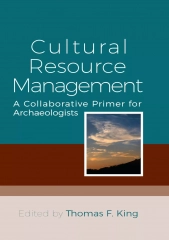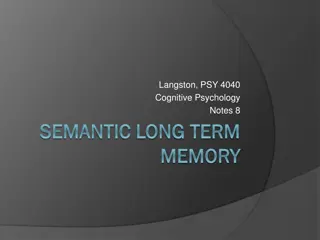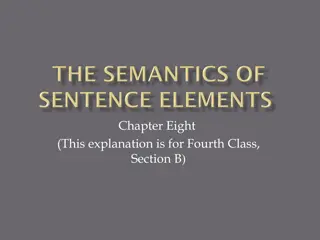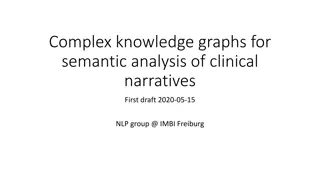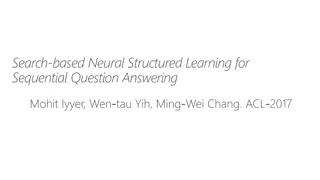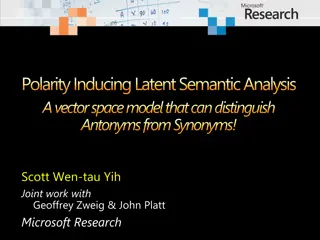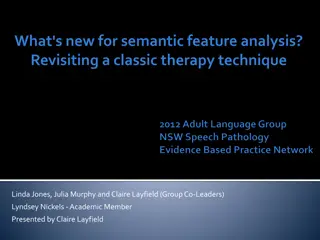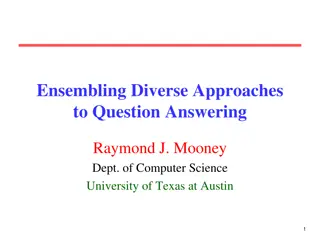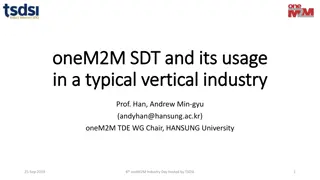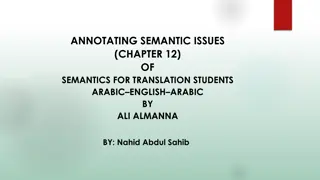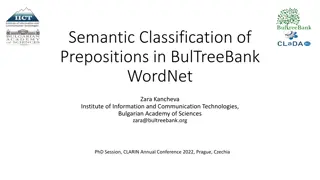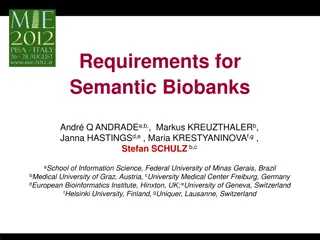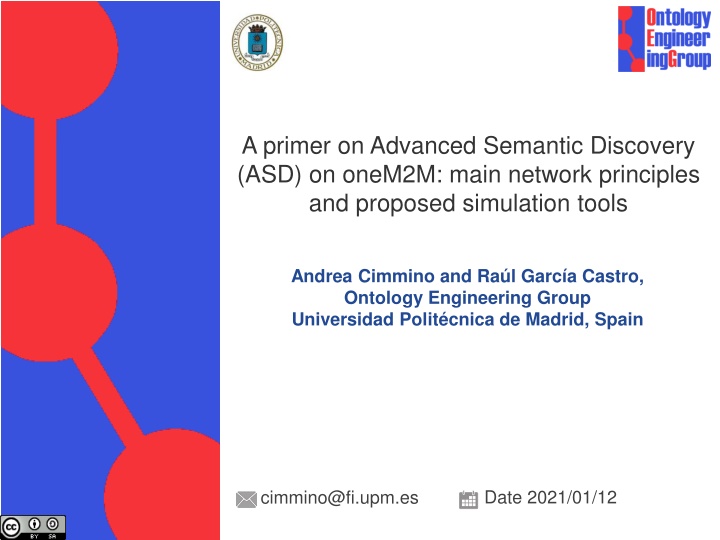
Advanced Semantic Discovery in oneM2M: Simulation Tools & Network Principles
Explore the principles of Advanced Semantic Discovery (ASD) in oneM2M, focusing on network principles and proposed simulation tools. The simulation scenarios cover local vs. distributed discovery, scaling distributed CSEs, and operations supported in one or multiple CSEs. Dive into the world of semantic descriptors, REST APIs, triple stores, and more for efficient discovery and relationship establishment in IoT systems.
Download Presentation

Please find below an Image/Link to download the presentation.
The content on the website is provided AS IS for your information and personal use only. It may not be sold, licensed, or shared on other websites without obtaining consent from the author. If you encounter any issues during the download, it is possible that the publisher has removed the file from their server.
You are allowed to download the files provided on this website for personal or commercial use, subject to the condition that they are used lawfully. All files are the property of their respective owners.
The content on the website is provided AS IS for your information and personal use only. It may not be sold, licensed, or shared on other websites without obtaining consent from the author.
E N D
Presentation Transcript
A primer on Advanced Semantic Discovery (ASD) on oneM2M: main network principles and proposed simulation tools Andrea Cimmino and Ra l Garc a Castro, Ontology Engineering Group Universidad Polit cnica de Madrid, Spain Date 2021/01/12 cimmino@fi.upm.es
Advanced Semantic Discovery (ASD) The simulation scenario Simulator of CSEs Conclusions Set your title here in Slide Master Options 2
The simulation scenario CSEM CSE1 CSE2 CSE3 TS1 TS2 TSM TS3 RDF RDF RDF RDF RDF RDF RDF RDF RDF RDF RDF RDF RDF RDF RDF RDF RDF RDF RDF RDF RDF RDF RDF RDF Semantic Descriptors Semantic Descriptors Semantic Descriptors Semantic Descriptors Set your title here in Slide Master Options 3
The simulation scenario: local vs distributed discovery SPARQL RDF RDF RDF RDF RDF RDF CSE1 TS1 IDs List Semantic Descriptors Set your title here in Slide Master Options 4
The simulation scenario: local vs distributed discovery SPARQL RDF RDF RDF RDF RDF RDF CSE1 TS1 IDs List Semantic Descriptors Distributed Topology CSE3 CSE2 RDF RDF RDF RDF RDF RDF TS1 TS1 RDF RDF RDF RDF RDF RDF Semantic Descriptors Semantic Descriptors Set your title here in Slide Master Options 5
The simulation scenario: scaling distributed CSEs CSEM CSE1 CSE2 CSE3 TS1 TS1 TSM TS1 RDF RDF RDF RDF RDF RDF RDF RDF RDF RDF RDF RDF RDF RDF RDF RDF RDF RDF RDF RDF RDF RDF RDF RDF Semantic Descriptors Semantic Descriptors Semantic Descriptors Semantic Descriptors REST API Named Graph 1 Named Graph 2 Named Graph 3 Named Graph M CSEs Simulator TripleStore Set your title here in Slide Master Options 6
The simulation scenario: scaling distributed CSEs Operations Supported Discovery in one CSE Discovery in multiple CSEs Create/Delete a new CSE Create/Delete/Read a Semantic Descriptor within an existing CSE Establish a relationship among existing CSEs REST API Named Graph 1 Named Graph 2 Named Graph 3 Named Graph M CSEs Simulator TripleStore Set your title here in Slide Master Options 7
The simulation scenario: scaling distributed CSEs CSEs Simulator Named Graph 1 Named Graph 2 Named Graph M TripleStore REST API RDF RDF RDF RDF RDF RDF RDF RDF RDF RDF RDF RDF Semantic Descriptors Semantic Descriptors RDF RDF RDF RDF RDF RDF Semantic Descriptors Automatic synthetic Semantic Descriptor generator Set your title here in Slide Master Options 8
ASD Discovery WoT module SAREF module SAREF for buildings module Simulation module Geo SPARQL module SAREF for cities module Set your title here in Slide Master Options 9
Advanced Semantic Discovery (ASD) The simulation scenario Simulator of CSEs Conclusions Set your title here in Slide Master Options 10
SPARQL semantic discovery: oneM2M vs W3C SPARQL RDF RDF RDF RDF RDF RDF CSE1 TS1 IDs List Semantic Descriptors SPARQL RDF RDF RDF RDF RDF RDF CSE1 TS1 Q.Results Semantic Descriptors Set your title here in Slide Master Options 11
Simulating oneM2M SPARQL semantic discovery PREFIX saref: <https://saref.etsi.org/core/> PREFIX sim: <http://etsi.stf-583/def/simulation#> SELECT ?AE_ID { GRAPH ?CSE_ID { ?CSE_ID sim:hasRegistered ?AE_ID . [Query statements go here, e.g. ?AE_ID a saref:TemperatureSensor. ] } VALUES?cse {<[ID of the CSE, e.g.,http://sim-test-cse.es/cse/4]>} } Mandatory statements in the query Variable statements in the query, provided by a user or an AE ID of the CSE, it has to be a URI Set your title here in Slide Master Options 12
Shortcomings of returning a list of IDs Find anything that measures temperature RDF RDF <<linked>> RDF SPARQL <<linked>> CSE1 RDF RDF TS RDF <<linked>> IDs list RDF Find anything that measures temperature and return its types Tell me the rooms of the building that have a temperature sensor Set your title here in Slide Master Options 13
Shortcomings of returning a list of IDs: efficiency and scalability Find anything that measures temperature and return its types Find anything that measures temperature RDF RDF <<linked>> RDF SPARQL <<linked>> CSE1 RDF RDF TS RDF IDs list <<linked>> 1. For each ID, retrieve its Semantic Descriptor 2. Aggregate the Semantic Descriptors 3. Solve the former query locally by a client (AE) RDF Set your title here in Slide Master Options 14
Shortcomings of returning a list of IDs: efficiency and scalability Tell me the rooms of the building that have a temperature sensor Find anything is either a sensor or a floor RDF RDF <<linked>> RDF SPARQL <<linked>> CSE1 RDF RDF TS RDF IDs list <<linked>> 1. For each ID, retrieve its Semantic Descriptor 2. Aggregate the Semantic Descriptors 3. Solve the former query locally by a client (AE) RDF Set your title here in Slide Master Options 15
Demo 1: Find anything that measures temperature PREFIX saref: <https://saref.etsi.org/core/> PREFIX sim: <http://stf-589-sim.es/core#> SELECT DISTINCT ?AE_ID { GRAPH ?CSE_ID { ?CSE_ID a sim:CSE . ?CSE_ID sim:hasRegistered ?AE_ID . ?AE_ID a ?type . ?AE_ID saref:measuresProperty ?property . ?property a saref:Temperature . } VALUES ?CSE_ID { <http://stf-589- sim.linkeddata.es/syntectic-cse-4>} } Set your title here in Slide Master Options 16
Demo 2: Find anything that measures temperature and return its types PREFIX saref: <https://saref.etsi.org/core/> PREFIX sim: <http://stf-589-sim.es/core#> SELECT DISTINCT ?AE_ID ?AE_type { GRAPH ?CSE_ID { ?CSE_ID a <http://stf-589-sim.es/core#CSE> . ?CSE_ID sim:hasRegistered ?AE_ID . ?AE_ID a ?AE_type . ?AE_ID saref:measuresProperty ?property . ?property a saref:Temperature . } VALUES ?CSE_ID { <http://stf-589- sim.linkeddata.es/syntectic-cse-4>} } Set your title here in Slide Master Options 17
Demo 2: Tell me the rooms of the building that have a temperature sensor PREFIX saref: <https://saref.etsi.org/core/> PREFIX sim: <http://stf-589-sim.es/core#> PREFIX rdfs: <http://www.w3.org/2000/01/rdf-schema#> SELECT DISTINCT ?AE_ID ?room_type { GRAPH ?CSE_ID { ?CSE_ID a <http://stf-589-sim.es/core#CSE> . ?CSE_ID sim:hasRegistered ?AE_ID . ?AE_ID a saref:TemperatureSensor . ?AE_ID saref:measuresProperty ?property . ?property saref:isPropertyOf ?floor . ?floor a ?room_type . } VALUES ?CSE_ID { <http://stf-589-sim.linkeddata.es/syntectic-cse-4>} } Set your title here in Slide Master Options 18
Advanced Semantic Discovery (ASD) The simulation scenario Simulator of CSEs Conclusions Set your title here in Slide Master Options 19
Conclusions Our simulator allows to emulate a variable number of CSEs and solve a discovery query (over one or more CSEs) o Additionally, it allows modifying the semantic descriptors of the CSEs dynamically o Allows modifying the existing CSEs dynamically Our simulator implements the oneM2M and W3C functionalities for discovery The improvement to oneM2M semantic discovery consists of returning a SPARQL W3C answer instead of a list of IDs o Allows exploratory queries o Improves efficiency and scalability o Prevents lost of information o 100% aligned with the W3C standard Set your title here in Slide Master Options 20
Questions? Set your title here in Slide Master Options 21

